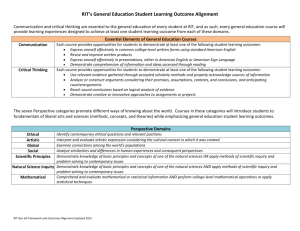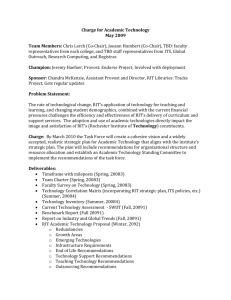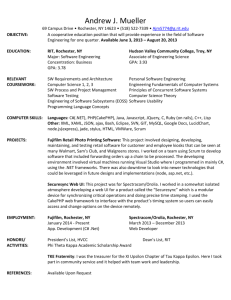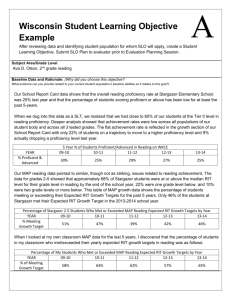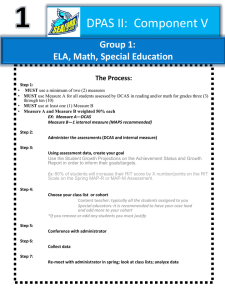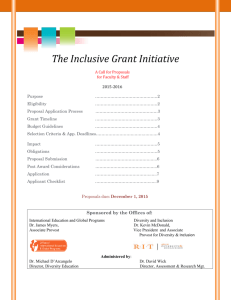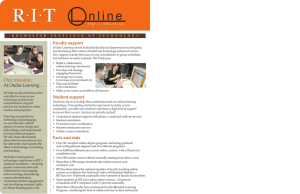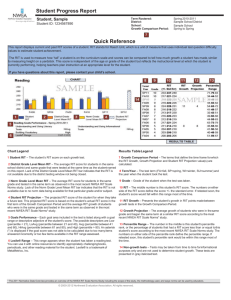RIT Standard Answers for Distance Ed Forms
advertisement
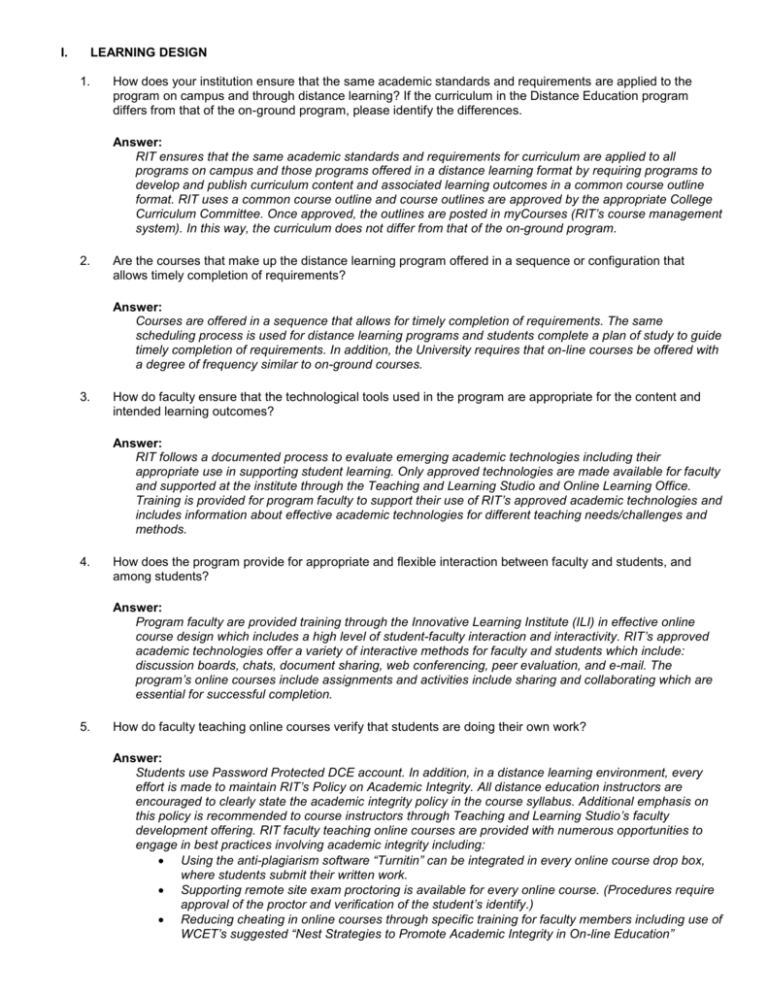
I. LEARNING DESIGN 1. How does your institution ensure that the same academic standards and requirements are applied to the program on campus and through distance learning? If the curriculum in the Distance Education program differs from that of the on-ground program, please identify the differences. Answer: RIT ensures that the same academic standards and requirements for curriculum are applied to all programs on campus and those programs offered in a distance learning format by requiring programs to develop and publish curriculum content and associated learning outcomes in a common course outline format. RIT uses a common course outline and course outlines are approved by the appropriate College Curriculum Committee. Once approved, the outlines are posted in myCourses (RIT’s course management system). In this way, the curriculum does not differ from that of the on-ground program. 2. Are the courses that make up the distance learning program offered in a sequence or configuration that allows timely completion of requirements? Answer: Courses are offered in a sequence that allows for timely completion of requirements. The same scheduling process is used for distance learning programs and students complete a plan of study to guide timely completion of requirements. In addition, the University requires that on-line courses be offered with a degree of frequency similar to on-ground courses. 3. How do faculty ensure that the technological tools used in the program are appropriate for the content and intended learning outcomes? Answer: RIT follows a documented process to evaluate emerging academic technologies including their appropriate use in supporting student learning. Only approved technologies are made available for faculty and supported at the institute through the Teaching and Learning Studio and Online Learning Office. Training is provided for program faculty to support their use of RIT’s approved academic technologies and includes information about effective academic technologies for different teaching needs/challenges and methods. 4. How does the program provide for appropriate and flexible interaction between faculty and students, and among students? Answer: Program faculty are provided training through the Innovative Learning Institute (ILI) in effective online course design which includes a high level of student-faculty interaction and interactivity. RIT’s approved academic technologies offer a variety of interactive methods for faculty and students which include: discussion boards, chats, document sharing, web conferencing, peer evaluation, and e-mail. The program’s online courses include assignments and activities include sharing and collaborating which are essential for successful completion. 5. How do faculty teaching online courses verify that students are doing their own work? Answer: Students use Password Protected DCE account. In addition, in a distance learning environment, every effort is made to maintain RIT’s Policy on Academic Integrity. All distance education instructors are encouraged to clearly state the academic integrity policy in the course syllabus. Additional emphasis on this policy is recommended to course instructors through Teaching and Learning Studio’s faculty development offering. RIT faculty teaching online courses are provided with numerous opportunities to engage in best practices involving academic integrity including: Using the anti-plagiarism software “Turnitin” can be integrated in every online course drop box, where students submit their written work. Supporting remote site exam proctoring is available for every online course. (Procedures require approval of the proctor and verification of the student’s identify.) Reducing cheating in online courses through specific training for faculty members including use of WCET’s suggested “Nest Strategies to Promote Academic Integrity in On-line Education” (www.wcet.wiche.edu). 6. For programs that prepare candidates for teacher or educational leadership certification: Explain how the required field/student teaching/practicum/internship experiences meet requirements for the selection of cooperating teachers (licensed/certified in the certification areas of candidates); college faculty supervision and assessment of candidates; and collaboration between the faculty supervisor and cooperating teacher in assessing the candidate within the goals and objectives of the program and the State Learning Standards. Answer: N/A II. OUTCOMES AND ASSESSMENT 1. Distance learning programs are expected to produce the same learning outcomes as comparable classroombased programs. How are these learning outcomes identified -- in terms of knowledge, skills, or credentials -in course and program materials? Answer: The distance learning and classroom-based programs have the same learning outcomes as documented on the program outcomes assessment plan. Program faculty develop and identify the knowledge and skills that students should be able to demonstrate throughout the program. All RIT programs are required to maintain this program level assessment plan which includes program goals, student learning outcomes, specific methods of measuring student learning, and achievement benchmarks. Assessment of these outcomes is done on a prescribed schedule. 2. Describe how the means chosen for assessing student learning in this program are appropriate to the content, learning design, technologies, and characteristics of the learners. Answer: Although the learning outcomes remain the same for programs offered in both on-site and distance formats, the method with which the student learning outcomes are measured may vary due to delivery method and student characteristics. Faculty choose a variety of assessment strategies in each course including: Test and Quiz methods may include: using test banks to provide varied questions requiring students to complete the exam at one time (no re-entry) setting shorter times for test completion (1-2 days vs. 1 week) setting password protected exams Assignments and Projects may include: emphasizing authentic written assignments collecting and grading various writing process components (outline, lit review, annotated bib, rough draft, final) giving focused assignments that are tied to the course making assignments cumulative (turn in parts of the project along the way – concept plan or proposal through finished product) III. PROGRAM EVALUATION 1. What process is in place to monitor and evaluate the effectiveness of the distance learning program on a regular basis? Answer: The program has a program assessment plan that is implemented on an established cycle. Annually, RIT monitors the effectiveness of each program’s assessment of program goals and student learning through a university-wide annual progress report completed by the program. The program meets at least once a year to review and discuss the effectiveness of the program. In addition, RIT moved to an online student rating of teaching effectiveness with common core questions. The information collected in course evaluations is the same for all learning formats. Students complete course evaluations for every course in the program. Course evaluations are included in the annual review by the program. The program routinely uses other methods to evaluate program effectiveness including: alumni surveys, student exit interviews, and employer surveys. 2. How will the evaluation results be used for continuous program improvement? Answer: As an institution, RIT is committed to a culture of continuous program improvement. In addition to maintaining program level assessment plans, the program is required to formally report on the use of outcomes assessment data for program improvement. The program is asked to provide evidence on how they use assessment results to make changes or improvements to teaching and learning. The program uses the course evaluations to work with faculty on improving teaching and learning. 3. How will the evaluation process assure that the program results in learning outcomes are appropriate to the rigor and breadth of the college degree or certificate awarded? Answer: The program uses the results from the assessments to continuously evaluate the program’s goals, outcomes, benchmarks, and monitor the quality of the student learning. The program established benchmarks for student achievement that are consistent with the appropriate rigor and breadth of the degree. The benchmarks ensure that students graduate with the competencies expected of the degree and are also reviewed as part of an iterative process.


